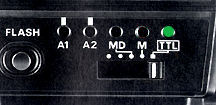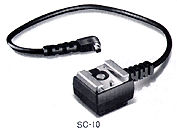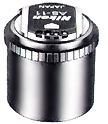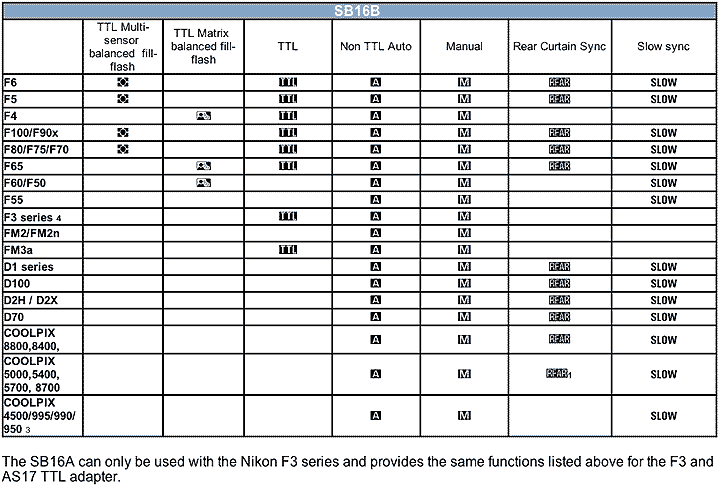TTL multiple
flash
photography
By using the SB-16 connected to an F3-series, FA, FE2, F-501/N2020, F-301/N2000,
FG or Nikonos-V (via V-Type Sync Cord) camera as a master flash unit and either the
Nikon Speedlight SB-11, SB-14, SB-15, SB-16, SB17, SB-18 and/or SB-140 as slave flash
unit(s), TTL multiple flash photography with up to five flash units can be performed.
 |
 |
|
 |
|
Manual multiple flash photography If the secondary flash unit is either a Nikon Speedlight SB-11, SB-12, SB-14, SB-15, SB-16 or SB-17, use either the SC-11 (approx. 25cm) or SC-15 (approx. 1m) sync cord to connect the flash units together via sync/multiple flash terminal. With the SB-7E or SB-10, use the SC-5 (approx. 15cm), SC-7 (approx. 25cm) or SC-6 (approx. 1 m). All these sync cords are available as optional accessories.
 |
 |
|
 |
 |
 |
 |
|
 |
TTL Remote Cord SC-17 (For models that have standard ISO-type accessory shoe) |
The coiled cord SC-17 enables the SB-15, SB-16B or SB-18 or even many Nikon AF flash units to be used up to one and half meters off a Nikon FA, FE2, F-501/N2020, F-301/N2000, or FG camera for TTL automatic flash operation. Even with the SG17, automatic sync speed setting and ready-light indication in the viewfinder are provided just as if the flash unit were mounted directly on the camera. The SC-17 which has two terminals for TTL multiple flash photography can be used to connect up to two slave flash units when the SB-16B is used as a master flash unit. A tripod socket is provided.
 |
|
 |
|
A tripod socket at the bottom enables the SB-16B mounted on the AS-10 to be fixed to a tripod. To perform TTL flash photography with two units using the SB16B as a slave flash unit or to perform TTL photography with three units using the SB-16B as a master flash unit mounted on the SC-17, use of the AS-10 is not always needed. Without the AS-10, however, the electrical contacts on the flash unit are uncovered and can be the cause of incorrect output control.
AS-11
 |
|
Flash Unit Couplers AS 1, 4, 5, 6, and 7
 |
 |
 |
 |
 |
 AS-17 AS-17 |
 |
|
``Red Eye'' "Red eye" is a phenomenon in flash photography where the centre portions of the subject's eyes appear as bright red orbs in colour photographs (or white in black and white pictures). This is a result of the light from the flash illuminating the retina directly. If the subject looks straight into the lens and there is little or no ambient light, the pupil is wide open, making the retina clearly visible in the picture. To minimize chances of getting "red eye," you can take any or all of the following precautions: 1. Ask the subject not to look directly into the lens when the picture is taken. 2. Remove the flash unit from the camera and hold it as far away as possible from the camera by using a sync cord. 3. Increase the room's overall illumination to reduce the opening of the subject's pupils.
Tips on Speedlight care and maintenance
 |
|
 |
|
 |
|
 |
|
After firing, wait until the ready-light lights, then turn off the power switch, remove the batteries, and store the SB-16 in a suitable location. This will prevent the condenser from deteriorating.
 |
• keep the flash unit away from salt water and out of the rain. |
 |
|
Optimum
Battery
Performance
New batteries. Between manufacturing and first use, all batteries exhibit
some drain. Therefore, care should be taken to purchase the newest (and freshest)
ones possible. To help you do this, some manufacturers stamp the date of manufacture
on the bottom of each battery. Ask your camera dealer for assistance in interpreting
the codes.
Temperature. Battery life ratings are based on operation at around 25°C
(77°F). At other temperatures, battery life is shortened. Spare batteries should
therefore be kept available if operation in low temperatures is anticipated.
Continuous use. Batteries are drained much more quickly by continuous use
than by intermittent use.
Storage. When not in use, the batteries should be removed to prevent damage
from leakage. To minimize drain during the period of disuse, store the batteries
in a cool, dry place below 20°C (68°F).
Battery brands. Do not mix brands of batteries, nor use batteries with different
model numbers. Also, avoid mixing new and old batteries since proper performance
will no be obtained and battery leakage may occur.
Disposal. Do not dispose of batteries by burning. Also, for safety's sake,
never disassemble batteries.
Polarity. When installing batteries, observe the voltage polarities carefully.
Reversal of the positive (+) and negative (-) terminals will result in leakage. If
leakage should occur, take the SB-16 to your dealer.
NiCd batteries. In comparison with regular batteries, NiCd batteries provide
faster recycling time and better efficiency at low temperatures. However, note that
the recycling time and the number of flashes per battery set are dependent on the
age of the batteries, how much charge they have, and their capacities.
 |
Nikon SB-16B (AS-`17) Flash / speedlight compatibility chart with various Nikon cameras. |
Specifications:
(The SB-16
main flash unit has the following specifications when combined with the Flash Unit
Coupler AS-8 or AS-9)
Electronic construction: Automatic silicon-controlled rectifier and series
circuitry
Guide number at ASA/ISO 100 and meters (or at ASA/ISO 25 and feet): At full
output: 32 (52) with the zoom head set at N; 19 (33) with the zoom head set at W1 and Wide-Flash Adaptor SW-7 attached
Angle of coverage: 60° horizontal and 45° vertical with the zoom head
set at N; 78° horizontal and 60° vertical with the zoom head set at W2 and Wide-Flash Adaptor attached
Flash Heads: Two flash heads provided; main head tilts back 90° with click
stops at the 30°, 45°, 60°, 75° and 90° positions and also rotates
through an arc of 270°, 90° clockwise with click stops at 30°, 60°
and 90° positions, and 180° counter clockwise with click-stops at 30°,
60°, 90°, 120°, 150° and 180° positions; the smaller secondary
head faces straight ahead to provide a catch light for the eyes
Zooming capability: Possible with four settings (T, S, N and W1 for 85mm, 50mm, 35mm and 28mm lens
Batteries: Four 1.5VM-type alkaline manganese penlight batteries or four 1.2VM-type
NiCd batteries recommended
Number of flashes and recycling time (on manual at 25°C)
|
Battery type |
Number of flashes* |
Recycling time |
|
Alkaline-manganese |
approx.100 times |
approx.11 sec. minimum |
|
NiCd** |
approx. 40 times |
approx. 8 sec. minimum |
* At full output; of course, more flashes
and shorter recycling times are possible in the TTL, non- TTL automatic, or MD mode
**
This
data depends on brand of battery and amount of recharging
TTL-automatic exposure: Through-the-lens automatic exposure control when the
SB-16A is combined with the Nikon F3-series camera or when the SB-16B is combined
with the Nikon FA, FE2, F-501/N2020,
F-301/N2000, FG or Nikonos-V; film speeds from ASA/ISO 25 to 400 with the FA, FE2,
FG or Nikonos-V, or ASA/ISO 25 to 1000 with F-501/N2020 or F-301/ N2000; usable aperture
range from f/2 to f/22
non-TTL-automatic exposure: Automatic exposure control via the front-mounted
light sensor; two working apertures depending on film speed (f/8 and f/4 at ASA/ISO
100) are usable and identified as A1 and A2
Manual exposure control: Full output at M setting
Synchronization with motor driven camera: Possible at MD setting with 1/16th
of full output. Guide number is 8 at ASA/ISO 100 and meters (or 13 at ASA/ISO 25
and feet) with the zoom head set at N; only main flash fires;
Dimensions (W
x H x D):
SB 16A: approx. 82mm x 166.5mm x 100mm
SB 16B: approx. 82mm x 144mm x 100 mm
Weight :
SB 16A: approx. 485g (without batteries)
SB 16B: approx. 445g (without batteries)
Accessories provided: Wide-Flash Adaptor SW-7; Soft Case SS-16; Battery Holder
MS-5
|
| Part
I | Part
II | Part III | Part IV | Part V | Part VI | Back to Index of Nikon Flash Back to Index of Nikon SB-16 Back to Index of Nikon F3 Model |
|
|||||
|
|||||||
